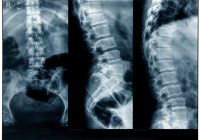Scoliosis is not an uncommon medical condition where an individual’s spine has a curve, shaped like an S or a C. This condition occurs most commonly during puberty growth spurts and therefore is most likely to occur in young children, pre-teens and teenagers.
Scoliosis can be caused by larger, overarching conditions, such as muscular dystrophy or cerebral palsy, but studies are still being conducted into what actually causes most cases of scoliosis. In the majority of cases, in 8 out of 10 cases, the cause of scoliosis isn’t known. This is known as idiopathic scoliosis.
Almost all cases of scoliosis are mild. However, in some cases, the condition can worsen over time and become severe scoliosis. This can be extremely debilitating. An extreme spinal curve can cause back pain, but also reduce the chest cavity and reduce lung function. If you suspect your child has a slight curvature of the spine, bring them in to see our Chiropractor in West Vancouver earlier rather than later. In most cases, the curvature is probably due to a growth spurt which can be managed and minimized early in life with chiropractic care.
Children With Scoliosis
Scoliosis can affect people of all ages, including babies and adults, but most cases of scoliosis occur between the age of 10 to 15. This is around the time that the body goes through its most significant changes, especially in terms of growth and height.
There are a few clear signs of scoliosis that can be diagnosed without a medical assessment. These include:
- Clothes don’t fit well
- One shoulder or hip that sticks out
- The body leans to one side
- A visible curvature of the spine
If any of these symptoms are noticed in a child it’s a good idea to visit our Chiropractor in West Vancouver for an evaluation. It is likely a mild case of scoliosis that doesn’t need further medical intervention, but it’s always wise to get it looked at in case it develops into anything more serious.
Scoliosis will be diagnosed with the assistance of X-rays. This is done to examine the curvature of the spine and how severe the curvature is. Measurements are taken after a standing x-ray is completed and compared to a scale for determining the degree of scoliosis. If it is scoliosis, there are several different treatments, both invasive and non-invasive, that can be used to help alleviate the symptoms or reduce the curvature of the spine.
For scoliosis in adults, there is an increased chance of back pain. It is generally unlikely that children will experience back pain from scoliosis.
Treating Scoliosis
Treatment for scoliosis depends on the age of the patient, how severe the curve is, and whether or not scoliosis has been diagnosed to get worse over time. The majority of people will not need to receive treatment or have surgery.
If severe scoliosis is noticed at an early age, when children are very young, a doctor may recommend a cast or plastic brace that supports the spine to grow in the correct form and to prevent the curve from getting any worse. A brace may also be recommended for older children to prevent the curve from getting worse as they progress through puberty.
Chiropractic care is generally recommended as the first stage of care to non-invasively manipulate the spine for proper growth and development. Most mild to moderate curvature of the spine will respond well to chiropractic care. Usually, a series of manipulations throughout the growth spurt years can indeed help correct any early signs of a spinal curvature.
Our Chiropractor in West Vancouver will determine whether a spinal curvature is considered an anatomical scoliosis (meaning that the spinal curvature is developing idiopathically), or if it’s a functional scoliosis (which means that the curvature could be occurring due to bad posture or short and tight muscles and ligaments). In both cases, chiropractic care can help at an early age to minimize or reduce the curvature.
When will surgery be recommended? On rare occasions, surgery may be the answer to control the growth of the increased curvature of the spine. This kind of operation can be safely carried out to reduce the severity of the curvature of the spine resulting in the person being able to lead a normal life without any back pain or breathing problems in the future.
Everyday Life With Scoliosis
Most people who have scoliosis can continue living their everyday life, going about ordinary activities, including sports and different exercises without even noticing the curvature in their spines.
There is very rarely any significant pain caused by mild to moderate scoliosis and it doesn’t cause any other serious health problems if left untreated.
Scoliosis also usually has an ‘endpoint’ which doesn’t get any worse once the body stops growing and the spine stops adjusting. On average, we all reach skeletal maturity when we reach 25 years old. At this point, all naturally occurring growth and fusion of the growth plates of the spine has been reached. The spine is now considered a “mature” spine and any curvature or scoliotic growth will also no longer continue.
For children and adolescents who need to wear back braces, this can be a cause of self-esteem issues and problems with body image. It’s good for all parties involved, both the children and the parents, to know what effect this can have over a long period. However, it might be better to wear a brace early in life before the maturity of the spine has reached. These braces are temporary and will no longer be needed as the child gets older. Feel free to reach out to our Chiropractor in West Vancouver if you have any questions or if you think someone you know has scoliosis.



